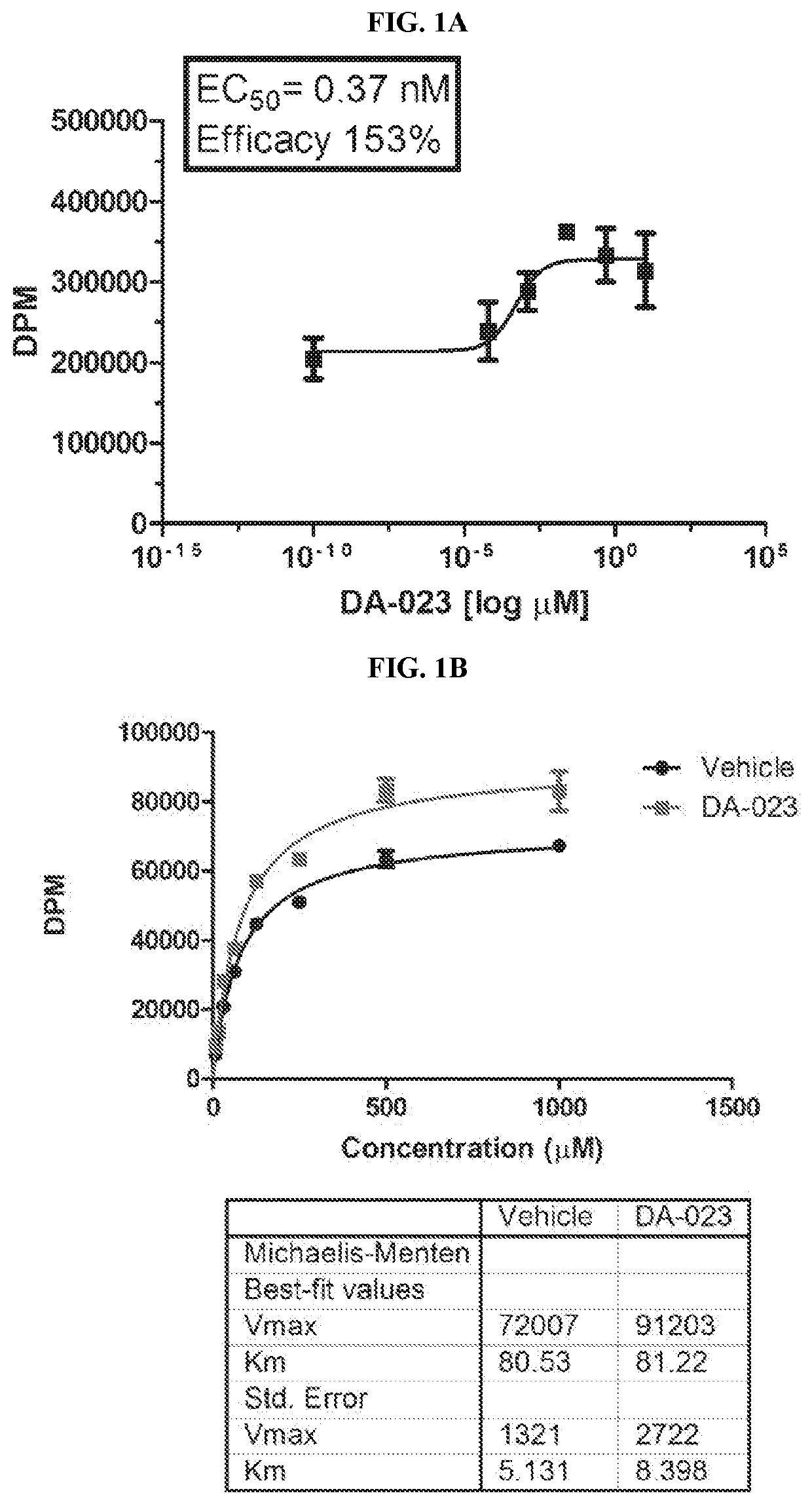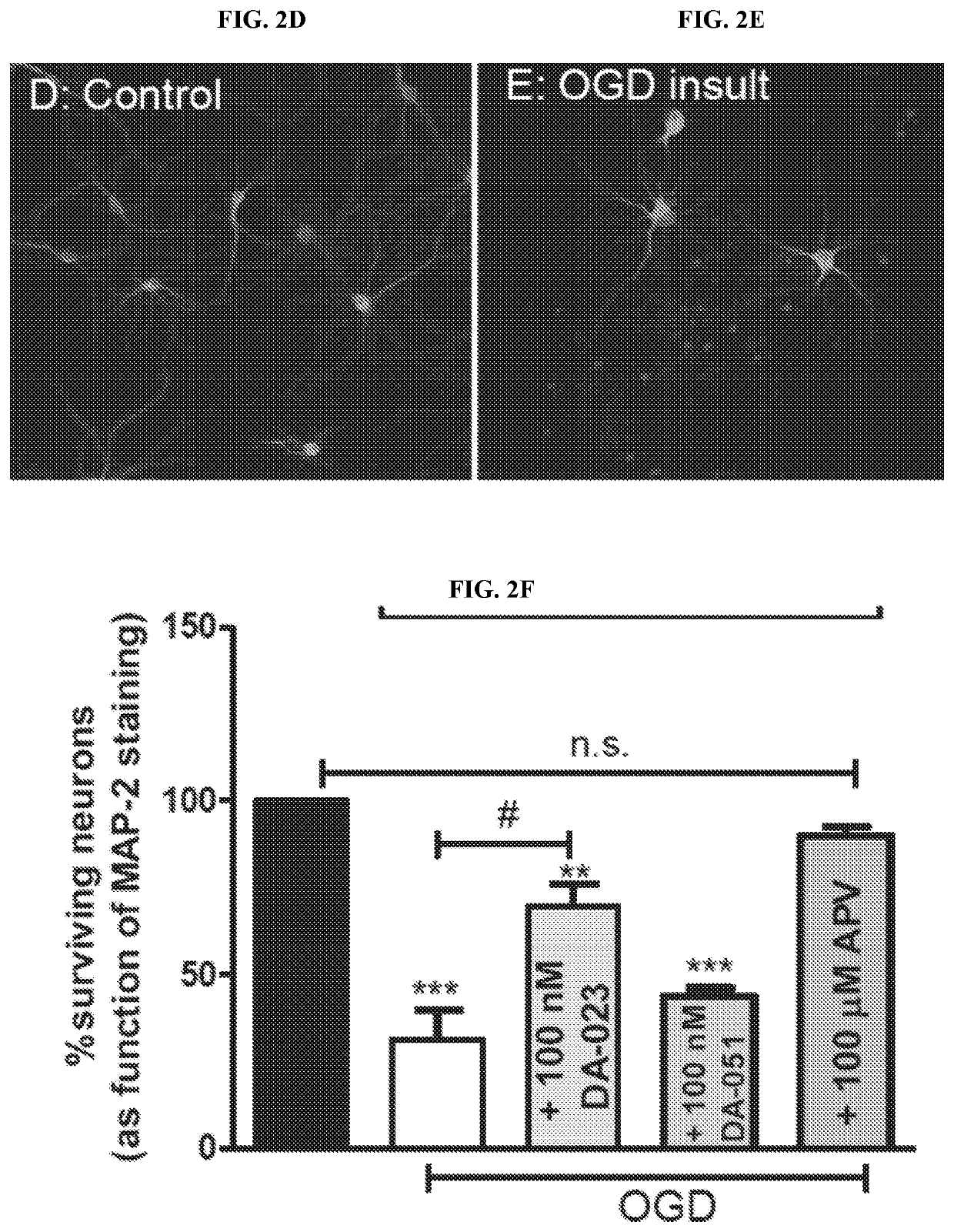Modulators of Excitatory Amino Acid Transporters and Methods Using Same
a technology modulator, which is applied in the field of modulators of excitatory amino acid transporters and methods using same, can solve the problems of increasing the predisposition to seizures and susceptibility to damage due to ischemia, no rationally designed transporter activator has been identified so far, and increasing the concentration of extracellular glutama
- Summary
- Abstract
- Description
- Claims
- Application Information
AI Technical Summary
Benefits of technology
Problems solved by technology
Method used
Image
Examples
example 1
of DA-023 and Analogs
[0209]
[0210]1-methyl-4-((1-phenethyl-1H-tetrazol-5-yl)(pyridin-3-yl)methyl)piperazine (DA-023): To a stirred solution of pyridine-3-carbaldehyde (100 mg, 0.93 mmol) in 3 mL of isopropanol was added 1-methylpiperazine (103 mg, 1.03 mmol), trimethylsilylazide (107 mg, 0.93 mmol) and (2-isocyanoethyl) benzene (122 mg, 0.93 mmol) were added to the reaction mixture and microwave at 100° C. for one hour. After completion of reaction as indicated by TLC reaction mixture cooled to room temperature, the solvent was evaporated under vacuum and crude residue was purified by flash chromatography using (0-15% methanol / dichloromethane) to obtain the pure compound (285 mg, 84.01% yield) as a white solid. 1H NMR (500 MHz, Chloroform-d) δ 8.56 (tt, J=3.5, 1.6 Hz, 1H), 8.35 (t, J=2.7 Hz, 1H), 7.79 (dq, J=8.0, 1.9 Hz, 1H), 7.28 (dddd, J=9.9, 5.1, 2.6, 1.1 Hz, 5H), 7.06-6.99 (m, 2H), 4.79 (ddt, J=10.4, 7.4, 5.3 Hz, 1H), 4.68 (dtd, J=13.5, 6.2, 2.9 Hz, 1H), 4.28 (d, J=2.7 Hz, 1H), 3...
example 2
of NA-014
[0211]
Ethyl 2-(4-cyanophenyl)acetate
[0212]Ethyl 2-(4-cyanophenyl)acetate (NA-001): To a solution of 4-cyanophenylacetic acid (40 g) in 250 mL ethanol was added catalytic amount of sulfuric acid (2 g). The reaction mixture refluxed for 24 h, then cooled to room temperature. Sat. NaHCO3 was added at 0° C. The solvent was evaporated and crude residue was diluted water and extracted into ethyl acetate. The EtOAC phase was concentrated and the residue was crystallized in EtOAc / hexane (1:2) to give a white solid 45 g. MS (ESI): m / z 190.1 [M+1]+.
Ethyl 2-bromo-2-(4-cyanophenyl)acetate
[0213]Ethyl 2-bromo-2-(4-cyanophenyl)acetate (NA-011): To a solution of ethyl 2-(4-cyanophenyl)acetate (18.9 g, 100 mmol) in 250 mL CCl4 at RT was added (PhCOO)2 (2.42 g, 10 mmol) and NBS (18.25 g, 102.5 mmol). The reaction mixture was heated to reflux for 3 h and additional NBS (1 g) was added. After additional 5 h, the reaction was cooled to RT and filtered. The filter was diluted with DCM and washed...
PUM
 Login to View More
Login to View More Abstract
Description
Claims
Application Information
 Login to View More
Login to View More - R&D
- Intellectual Property
- Life Sciences
- Materials
- Tech Scout
- Unparalleled Data Quality
- Higher Quality Content
- 60% Fewer Hallucinations
Browse by: Latest US Patents, China's latest patents, Technical Efficacy Thesaurus, Application Domain, Technology Topic, Popular Technical Reports.
© 2025 PatSnap. All rights reserved.Legal|Privacy policy|Modern Slavery Act Transparency Statement|Sitemap|About US| Contact US: help@patsnap.com



